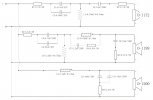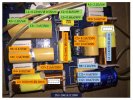Jeff,
Hi, thanks for your feedback, you seem to know a lot about crossovers. Would you be willing to post a sketch of what you think would be a better way to design the Linton crossover? I'm not trolling you, I'm really interested to know exactly what you would do if owned Linton's?
Or maybe this...have you every made a YouTube video? Perhaps you could do a video where you discuss crossover basics, the function of the various components on an XO board, what you like and don't like about the Linton crossover, and what your take on an improved design might look like?
There are a lot of videos on YT but they're pretty rough or have significant gaps in there ability to explain things in terms that a junior DIY guy can grasp.
The problem for many of us is we don't have someone to learn from...like myself, I have zero-access to someone that even remotely understands crossovers or drivers or cabinets or acoustic etc, and if they do have the experience, can they explain any of it.
As it is, I've spent an embarrassing amount of time on the internet during 1-1/2 years of COVID lockdowns and gotten nowhere.
BTW do you have any speaker projects documented anywhere? I'd be interested to look at how you worked through a crossover upgrade.
Thanks for whatever you can do, or not,
DK
Hello DK,
OK, I just came across your post. No, I am not a speaker designer, nor am I any crossover expert. I have been building tube amps, and have had two fabulous audio mentors over the decades, to learn from. What I have learned about amps, and tube amp design and modding, in regards to capacitors and resistors, similarly applies to crossovers IMHO.
After a lifetime of audio chasing, I now have a very simple system, a two way speaker, both drivers horn loaded, having over 101 dB efficiency. So I would never own Wharfdale Lintons and such, even though they may sound nice.
Why ?? I want to own and use a system that will play well, on 2 Watt or less tube amps I can design and build. These are the best sounding audio amps to my ears, and it is my preferred way to achieve a high performance. Start with a good 101 dB or higher speaker, preferably a two way with a 15 inch woofer. Preferably, ......both drivers horn loaded.
Crossovers for my two-way speaker have been 12 dB octave Butterworth, at about 800 Hz.
As I learn things, I make changes. Here is what my crossovers looked like in 2018, three years ago :
First of all NO PC boards, all Military Spec wiring ( m22759/11 ) is installed, Pictured next, below, is low loss
WIRING MAINLY, before the caps are added :
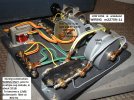
Now, where I differ from
almost all other people in audio is in my understanding and use of multiple film caps, ( where almost everyone else employs a single cap ). In your schematic to the Linton tweeter, we see use of 6.8 uF and an a 15 uF cap, in series with the audio signal. While those Wharfdale values may be necessary, to
get a certain frequency of crossover-driver filtering,
there is no way, in a million years, that such size caps are capable of playing High Frequency MUSIC information in an acceptable manner.
Cap basics: The smaller the uF value of a cap, generally speaking, the higher in frequency it responds and plays back music to us. Conversely, the larger the cap, the less it will play back to us the
midrange to the highest frequencies, in any ALL-OUT manner.
It takes multiple film caps, each of a successively smaller uF size, to obtain the FULLEST of fidelity, from any single cap position !! Only about 1-to-5% of the people in this world know this, and
only about 1% of that small group, KNOW what values to use, to multiple film bypass caps properly . ( It is all done by ear , listening to music. )
So, where " everyone " has ONE capacitor in a crossover, I might have EIGHT high quality film caps, of successively smaller uF values.
Each uF size plays a different part of the spectrum, and ALL are needed, and determined by ear, so as not to have any non linear playback ( holes ) in one's by-ear-perceived frequency response.
No friends, I am not pulling your legs. Here is what " ONE capacitor spot" looks like, close up, on what I prototype . Look :
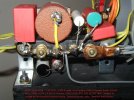
Now, it gets better !! What you do for bypassing a single cap position for the tweeter,
you MUST use the same cap arrangement for the midrange driver section - below the tweeter !! That way, they blend perfectly, harmonically, and at the highest play-back level for each driver's range of play back.
This shot below will show TWO " SINGLE CAP POSITIONS" ( with
equal multiple caps in each position ) for my tweeter and for my woofer, an early 800Hz crossover, later improved upon.. Again, I am not joking around here , SEE :
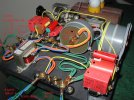
" What you do with multiple film cap bypassing to one section ( the tweeter ) ,
you also precisely do to the other section ( woofer ) " It is costly !!
In about early 2020, I did the
ultimate crossover mod, to the woofer in my two way ALTEC speaker system. What is that ?? I
eliminated the crossover to the woofer completely, and allowed the
lovely-sounding 515B fifteen inch woofer to play
full range !! KISS rules in ultra high end audio. No crossover on the woofer, to degrade it's inherent performance. It is superior, no comparison. Half the crossover parts on the above photos are GONE !!

In 2021, I installed a better L-Pad to reduce the signal level to my tweeter. In mid 2021, I totally eliminated the entire L-Pad, and replaced it,
not with a single-value high-sound-quality resistor, but with special resistance wire, 4 and 3/8 ths inches long did it . ( Constantan and Manganin wire ).
What to do with your Linton Wharfdales?? Well,
it's a totally huge project !!!! The crossover has to be made four times larger, come out of the box, and you need a year of so of futzing, assuming you KNEW what uF values play in what music range, .........which you don't. And you can't use a 1.5 Watt SE tube amp on it when you are done. :-(
No, I will not do a video. People won't get it. Audio people have not " gotten it " in audio amps, after 30+ years of me trying, and I am not too confident when it comes to speakers !!
Jeff


